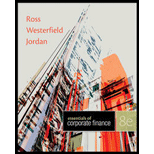
a)
To calculate: The
Introduction:
Rate of return refers to the gain or loss on the investment. It also refers to the increase or decrease in the capital value of an investment.
The
a)
Answer to Problem 16QP
A bond with a face value of $50 would double its value in 20 years, if the rate of return is 3.53%.
Explanation of Solution
Given information:
Person X purchased a bond worth $50. He plans to hold it for 20 years until the value of the bond, doubles.
The formula to calculate the rate of return:
Where,
“P” refers to the principal amount invested,
“r” refers to the simple rate of interest,
“t” refers to the number of years or periods of investment,
“FV” refers to the future value or the current market value.
Compute the rate of return:
The
Hence, the rate of return is 3.53% per year.
b)
To calculate: The future value of the bond
b)
Answer to Problem 16QP
The value of the bond in 2022 will be $53.08.
Explanation of Solution
Given information:
Person X will purchase a bond worth $50 in 2012. He plans to hold it until 2022 that is for 10 years. The rate of interest on the bond is 0.60 percent per year.
The formula to compute the future value:
Where,
“FV” refers to the future value or the current market value,
“PV” refers to the present value,
“r” refers to the simple rate of interest,
“t” refers to the number of years or periods of investment.
Compute the future value:
Hence, the future value of investment after 10 years is $53.08.
c)
To calculate: The rate of return
c)
Answer to Problem 16QP
The bond has to fetch a return of 7.18% per year to double its value in 2032.
Explanation of Solution
Given information:
Person X purchased a bond worth $50 in 2012. He plans to hold it until 2022 that is for 10 years. The rate of interest on the bond is 0.60 percent per year. The future value of this bond in 2022 will be $53.08 (Refer Part (b) of the Answer). Instead of cashing the bond at $53.08, he plans to reinvest the
The formula to calculate the rate of return:
Where,
“P” refers to the principal amount invested,
“r” refers to the simple rate of interest,
“t” refers to the number of years or periods of investment,
“FV” refers to the future value or the current market value.
Compute the rate of return:
The present value of the bond is $53.08 in 2022. He plans to invest for 10 years until the value of the bond doubles in 2032. Hence, the future value of the bond will be $106.16
Hence, the bond has to fetch a return of 7.18% per year to double its value in 2032.
Want to see more full solutions like this?
Chapter 4 Solutions
Essentials of Corporate Finance
- The internal rate of return (IRR) is:A) The discount rate that makes the net present value (NPV) of a project zeroB) The rate of return required by investorsC) The interest rate on a bank loanD) The growth rate of dividendsexplainarrow_forwardThe internal rate of return (IRR) is:A) The discount rate that makes the net present value (NPV) of a project zeroB) The rate of return required by investorsC) The interest rate on a bank loanD) The growth rate of dividendsarrow_forwardWhich of the following is considered a risk-free investment?A) Corporate bondsB) Common stockC) Treasury billsD) Mutual fundsexplain.arrow_forward
- Which of the following is considered a risk-free investment?A) Corporate bondsB) Common stockC) Treasury billsD) Mutual fundsarrow_forwardHello submitted blurr image please comment i will write values. please dont Solve with incorrect values otherwise unhelpful.arrow_forwardWhat does the beta of a stock measure?A) The company’s profitabilityB) The volatility of the stock compared to the marketC) The dividend payout ratioD) The time value of moneyexplain.arrow_forward
- Which of the following is an example of a capital budgeting decision?A) Deciding how much inventory to holdB) Choosing which long-term project to invest inC) Determining how to finance a short-term loanD) Managing daily cash flow explain.arrow_forwardWhat does the beta of a stock measure?A) The company’s profitabilityB) The volatility of the stock compared to the marketC) The dividend payout ratioD) The time value of moneyarrow_forwardWhich of the following is an example of a capital budgeting decision?A) Deciding how much inventory to holdB) Choosing which long-term project to invest inC) Determining how to finance a short-term loanD) Managing daily cash flowarrow_forward
- What is the formula for the present value of a single future cash flow?A) FV × (1 + r)^nB) FV ÷ (1 + r)^nC) FV × r × nD) FV × (1 - r)^nexplain.arrow_forwardWhat is the formula for the present value of a single future cash flow?A) FV × (1 + r)^nB) FV ÷ (1 + r)^nC) FV × r × nD) FV × (1 - r)^narrow_forwardThe time value of money concept is based on the idea that:A) A dollar today is worth less than a dollar in the futureB) A dollar today is worth more than a dollar in the futureC) Money loses value over time due to inflationD) Future cash flows have no value Explain.arrow_forward
 Essentials Of InvestmentsFinanceISBN:9781260013924Author:Bodie, Zvi, Kane, Alex, MARCUS, Alan J.Publisher:Mcgraw-hill Education,
Essentials Of InvestmentsFinanceISBN:9781260013924Author:Bodie, Zvi, Kane, Alex, MARCUS, Alan J.Publisher:Mcgraw-hill Education,

 Foundations Of FinanceFinanceISBN:9780134897264Author:KEOWN, Arthur J., Martin, John D., PETTY, J. WilliamPublisher:Pearson,
Foundations Of FinanceFinanceISBN:9780134897264Author:KEOWN, Arthur J., Martin, John D., PETTY, J. WilliamPublisher:Pearson, Fundamentals of Financial Management (MindTap Cou...FinanceISBN:9781337395250Author:Eugene F. Brigham, Joel F. HoustonPublisher:Cengage Learning
Fundamentals of Financial Management (MindTap Cou...FinanceISBN:9781337395250Author:Eugene F. Brigham, Joel F. HoustonPublisher:Cengage Learning Corporate Finance (The Mcgraw-hill/Irwin Series i...FinanceISBN:9780077861759Author:Stephen A. Ross Franco Modigliani Professor of Financial Economics Professor, Randolph W Westerfield Robert R. Dockson Deans Chair in Bus. Admin., Jeffrey Jaffe, Bradford D Jordan ProfessorPublisher:McGraw-Hill Education
Corporate Finance (The Mcgraw-hill/Irwin Series i...FinanceISBN:9780077861759Author:Stephen A. Ross Franco Modigliani Professor of Financial Economics Professor, Randolph W Westerfield Robert R. Dockson Deans Chair in Bus. Admin., Jeffrey Jaffe, Bradford D Jordan ProfessorPublisher:McGraw-Hill Education





